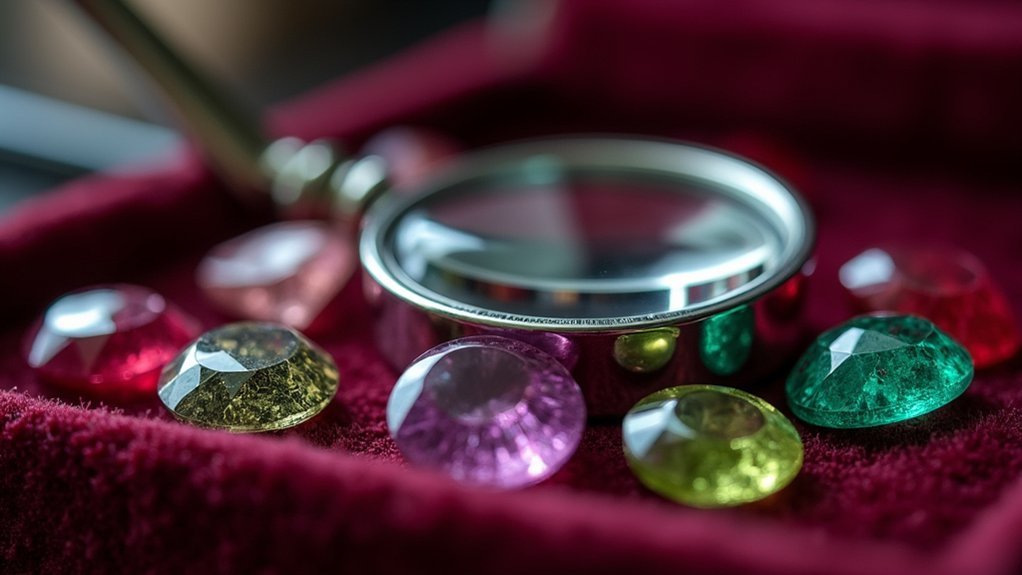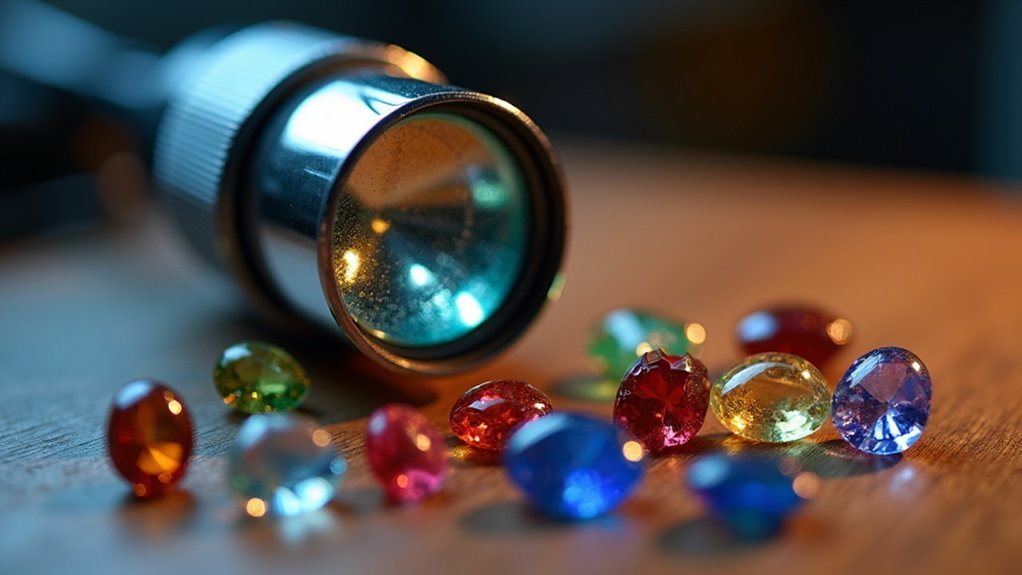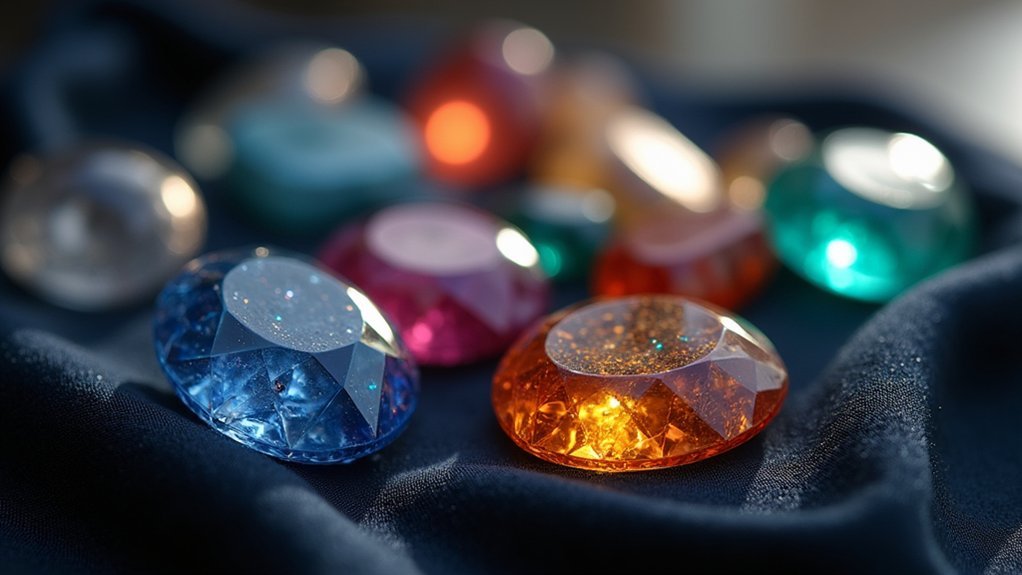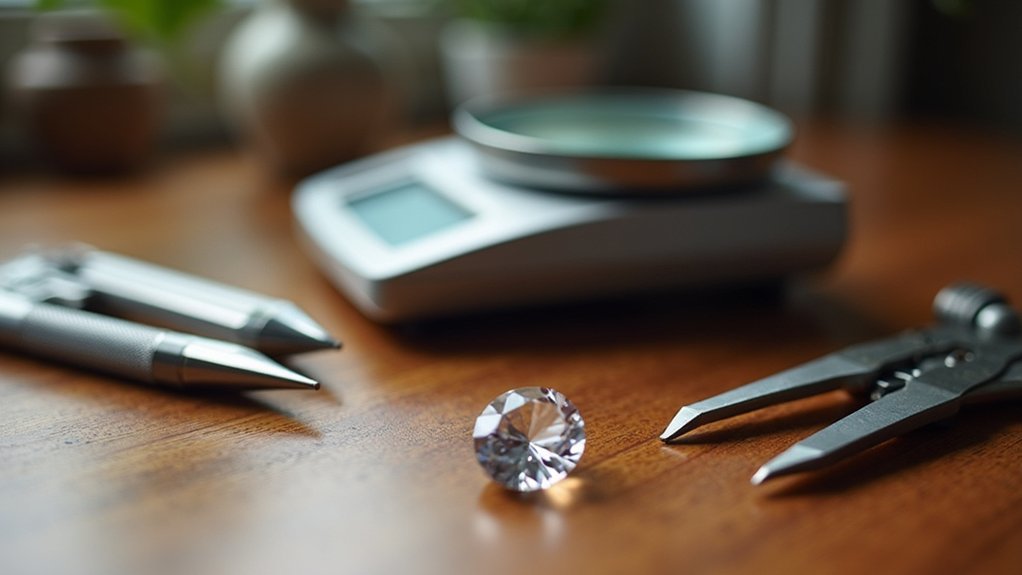You’ll need seven essential tools for accurate handmade gem appraisals: a 10x triplet loupe for detailed surface examination, a gemological microscope for inclusion analysis, a refractometer to measure refractive index, a precision digital scale for exact carat weight, a handheld spectroscope for gemstone identification, professional soft-tip tweezers for safe handling, and proper lighting equipment including incandescent and UV sources for color assessment. Each tool reveals specific characteristics that determine authenticity, quality, and value, ensuring you don’t miss critical details that could affect your evaluation.
10x Triplet Loupe for Detailed Gemstone Examination

When you’re examining handmade gem pieces, a triplet loupe becomes your most vital magnification tool. This high-quality device combines three lenses to minimize distortion and deliver exceptional clarity for detailed gemstone examination.
The standard 10x magnification lets you closely inspect inclusions, color variations, and cut quality that directly impact your jewelry appraisal accuracy.
10x magnification reveals critical inclusions, color variations, and cut details that determine accurate jewelry appraisal values.
Unlike economy loupes, triplet loupes provide accurate color representation, making them essential for discerning subtle hue differences during evaluations. Their dark-colored bodies reduce glare and improve your ability to spot fine details.
Investing in a quality triplet loupe greatly impacts your appraisal precision, as even minor gemstone characteristics can affect overall value. For professional jewelry appraisal work, this tool’s superior optics make it indispensable.
Gemological Microscope for Inclusion Analysis
Professional gem appraisal demands precision that only a gemological microscope can deliver. You’ll achieve magnification levels of 40x or higher, revealing internal characteristics invisible to standard loupes. This enhanced visibility becomes essential for gemstone identification, as you can distinguish between natural and synthetic stones through unique inclusions and growth patterns.
You’ll benefit from adjustable lighting systems that illuminate important features affecting your appraisal accuracy. Most quality models feature dual-lighting capabilities, combining transmitted and reflected light to examine different gemstone aspects simultaneously. This thorough illumination helps you identify treatments that might otherwise go undetected.
When appraising handmade gem pieces, you’ll find the microscope’s detailed inclusion analysis invaluable for evaluating overall quality and authenticity, making it an indispensable tool for professional evaluations.
Refractometer for Measuring Refractive Index

You’ll find a refractometer invaluable for measuring your gemstone’s refractive index, which helps you identify the exact gem type through its unique RI value.
The instrument works by shining light through your stone and measuring how that light bends, giving you precise optical data that’s vital for accurate appraisal.
You can also use it to detect birefringence and determine the optic sign, which are essential factors in distinguishing natural gems from synthetic alternatives.
How Refractometers Work
Although gemstones can look remarkably similar to the naked eye, a refractometer reveals their true identity by measuring how light bends as it passes through each stone’s unique crystal structure.
You’ll place your gemstone on the instrument’s prism where light enters and refracts at specific angles. The refractometer measures this angle against a calibrated scale to determine the stone’s refractive index.
You can also identify whether your gemstone is singly or doubly refractive by observing its birefringence and optic sign.
Most handheld models cover a range from 1.30 to 1.80 RI, accommodating nearly all gemstones you’ll encounter.
Before testing, you’ll need to calibrate your refractometer using a reference liquid with a known refractive index for accurate readings.
RI Values Identification
Why does knowing specific RI values matter when you’re appraising handmade gem pieces? You’ll need these precise measurements to distinguish between similar-looking stones and detect any treatments or enhancements. Each gemstone has a unique RI fingerprint that jewelry appraisers rely on for accurate identification.
When you measure RI values, you’re comparing how light behaves in different materials. Here’s a reference table for common gemstones:
| Gemstone | RI Range | Typical Value |
|---|---|---|
| Diamond | 2.417-2.419 | 2.418 |
| Ruby/Sapphire | 1.762-1.778 | 1.770 |
| Emerald | 1.577-1.583 | 1.580 |
| Quartz | 1.544-1.553 | 1.549 |
These values help you verify authenticity and assess birefringence properties. You’ll also detect synthetic materials or treatments that alter natural RI readings, ensuring accurate appraisals for handmade pieces.
Birefringence and Optic Sign
Taking those RI measurements one step further, your refractometer reveals birefringence—the difference between a gemstone’s highest and lowest refractive index readings. This optical property distinguishes between single-refractive stones like diamonds and garnets, which show one RI reading, and double-refractive gems like sapphires and emeralds, which display two distinct readings.
You’ll calculate birefringence by subtracting the lower RI from the higher one. Strong birefringence indicates certain gem types, while weak birefringence suggests others.
Additionally, determining the optic sign—whether positive or negative—provides essential crystallographic information. Positive stones have their highest RI along the optic axis, while negative stones show the opposite.
This combination of birefringence measurements and optic sign determination helps you identify gemstones with greater precision than RI values alone.
Precision Scale for Accurate Carat Weight

You’ll need to understand scale calibration standards to guarantee your measurements meet industry requirements for professional appraisals.
When choosing between digital and analog options, you’ll find digital scales offer superior precision and easier readability for carat weight measurements.
Consider the capacity and sensitivity specifications carefully, as you’ll want a scale that handles your typical gemstone sizes while providing the 0.01-gram accuracy essential for valuable pieces.
Scale Calibration Standards
When appraising handmade gem pieces, you’ll need a precision scale that delivers accurate carat weight measurements down to the hundredth of a gram. The GEMORO® Platinum XP500 Scale offers the reliability you need with its 500-gram capacity.
However, your scale’s accuracy depends entirely on proper scale calibration standards. You must regularly calibrate against standardized weights to maintain industry compliance and prevent costly valuation errors. Even minor inaccuracies can dramatically affect market pricing during appraisals.
For additional verification, use a balance beam scale with heavy liquids to measure specific gravity. This dual approach confirms both carat weight and quality.
Regular calibration isn’t optional—it’s essential for maintaining professional credibility and ensuring accurate gemstone valuations.
Digital Vs Analog
Although both digital and analog scales can measure gemstone weight, digital precision scales deliver superior accuracy that’s essential for professional appraisals. You’ll find that digital scales typically provide measurements accurate to 0.01 carats, while analog scales only achieve 0.1-carat precision. This difference matters greatly when evaluating valuable handmade pieces.
Digital scales offer practical advantages you’ll appreciate during appraisals. Their LCD displays provide clear, immediate readings without requiring interpretation of dial positions. You can utilize tare functions to eliminate container weight, ensuring precise gem measurements.
Quality models like the GEMORO® Platinum XP500 handle weights up to 500g, accommodating various piece sizes.
Calibration becomes simpler with digital scales through straightforward electronic adjustments, while analog scales demand more complex manual calibration procedures. For professional gem appraisal work, digital scales consistently outperform analog alternatives.
Capacity and Sensitivity
Precision scales with adequate capacity and exceptional sensitivity form the foundation of accurate gem appraisal work.
You’ll need a scale like the GEMORO® Platinum XP500 Scale, which offers 500-gram capacity with measurements precise to 0.01 grams for exact carat weight readings. In the jewelry industry, sensitivity matters enormously since tiny discrepancies can drastically impact valuations of your handmade pieces.
Choose scales featuring tare functions to zero out container weights, ensuring you’re measuring only the gemstone itself.
Look for easy-to-read digital displays that reduce measurement errors during your appraisal process. Remember, regular calibration is essential to maintain accuracy over time, keeping your gem weight assessments reliable for both appraisals and sales transactions.
Handheld Spectroscope for Gemstone Identification

One of the most valuable tools in your gemstone appraisal arsenal is the handheld spectroscope, a compact device that reveals a gem’s unique optical fingerprint by analyzing its light absorption spectrum.
This essential instrument uses either a diffraction grating or prism to separate light into component colors, providing critical insights into your gem’s composition and authenticity.
You’ll find the calibrated scale particularly useful for measuring absorbed light wavelengths, helping you distinguish natural stones from synthetic alternatives.
The handheld spectroscope’s portable design makes it perfect for appraisals at trade shows or client meetings, ensuring you’re always equipped for on-the-go assessments.
At around $26.90, investing in a quality handheld spectroscope greatly enhances your ability to evaluate gemstone authenticity and quality effectively.
Professional Tweezers for Safe Stone Handling
While the handheld spectroscope helps you identify gemstones accurately, you’ll need professional tweezers to handle these valuable stones safely during examination.
Tools like D-Master Soft Tip Tweezers are essential for professional jewelry appraisal, preventing scratches and damage to delicate gemstones.
Professional-grade tweezers with soft tips are crucial for safely handling valuable gemstones during appraisal without causing surface damage.
High-quality tweezers enhance your assessment accuracy by providing:
- Secure grip prevention – Soft tips eliminate slippage during stone manipulation
- Contamination control – Avoid transferring oils from your fingers to gemstones
- Enhanced visibility – Better control when examining stones under magnification
- Durability assurance – Stainless steel construction resists corrosion and maintains hygiene standards
Professional tweezers allow precise placement and manipulation of gemstones without compromising their integrity, making them indispensable for accurate handmade jewelry evaluations.
Proper Lighting Equipment for Color Assessment

After securing your gemstones with professional tweezers, accurate color assessment depends entirely on your lighting setup.
You’ll need multiple lighting sources to evaluate handmade gem pieces properly. Incandescent lights provide warm illumination that closely mimics natural sunlight, making them ideal for color comparison. However, natural daylight during overcast conditions offers the most balanced spectrum for true color representation.
Avoid fluorescent lighting entirely, as it distorts gemstone colors considerably. Instead, shield or turn off these lights during assessments.
Incorporate longwave and shortwave UV lights into your toolkit—they’ll help identify specific gems and detect treatments that aren’t visible under standard illumination.
Invest in adjustable, flexible lighting equipment that allows you to control angles and intensity, ensuring the best conditions for accurate color evaluation.
Frequently Asked Questions
What Is the Best Tool for Gem Testing?
You’ll find a gemological microscope’s your most essential tool for gem testing. It provides detailed examination of inclusions and clarity at 40x magnification or higher, allowing you to accurately identify and authenticate gemstones.
How Do I Find Out What My Gemstone Is Worth?
You’ll need a certified gemologist’s professional appraisal considering cut, clarity, color, and carat weight. Research current market prices for similar stones and factor in origin, rarity, and any treatments affecting value.
How Do I Get Gemstones Valued?
You’ll need to consult a certified gemologist with GIA or AGS credentials. They’ll examine your stones using specialized tools like microscopes and spectroscopes to provide an accurate, professional appraisal report.
What Good Looks Help Determine the Value of a Precious Stone?
You’ll assess four key factors: carat weight, cut quality, color grade, and clarity level. Cut affects brilliance, color involves hue and saturation, while clarity examines inclusions that impact the stone’s overall market value.
In Summary
You’ll transform your handmade gem appraisal process with these seven essential tools. Your 10x loupe and microscope will reveal every detail, while your refractometer and spectroscope guarantee accurate identification. Don’t forget your precision scale for exact measurements and quality tweezers for safe handling. With proper lighting equipment, you’ll assess colors like a pro. These tools aren’t just investments—they’re your gateway to confident, professional gem evaluation that’ll elevate your craftsmanship standards.





Leave a Reply